Revolutionizing the Offline Commerce Market - CARRY PROTOCOL
It is truly no doubt that the e-commerce industry has been growing exponentially in the recent years. This can be attributed to the ever-growing number of users who make use of mobile devices globally. According to research, the number of mobile phone users has been predicted to be more than 5 billion by 2019. The reason for this cannot be far-fetched. The average human being just wants comfort. This can also be attributed to the ever-changing nature of human, and all thanks to technology that's able to meet up with the human demands.

In spite of this, it is shocking to know that majority of the commerce trades still takes place in the offline market. In a research conducted by AT Kearney, it was observed that 90% of all the retail spending in America took place offline. This means consumers still prefer to go to traditional stores to purchase items. In addition, the big names in the commerce industry still invest heavily in offline businesses. In spite of these of these figures, the offline market still seems to be backward technology wise. Ideally, with such a huge market capitalization, the reverse should be the case.
According to research carried out by Carry Protocol, they were able to identify three major issues that could warrant this. It was observed that most merchants really do not understand their customers, consumers do not have ownership or authority over their data, and most offline business still make use of old-fashioned advertising methods.
As it is with online commerce where it's very easy to pinpoint customers' data, the reverse is the case with offline domains. This is because data is shared between different parties in the offline market, thereby making it very hard to amalgamate customers' data. A typical example of this is, merchants, know what a customer acquired but cannot decipher the customer's identity. On the other hand, payment companies, however, know the customer's identity but do not know what he/she purchased. Due to the limited access to data for both parties, it becomes very difficult and impossible to have a true picture of the data which help track the offline market purchasing behaviour.
Another major issue is advertising. Most offline businesses make use of old-fashioned advertising methods, which in the real sense, is very cumbersome, highly expensive, stressful, ineffective and untraceable. Also, customers do not have ownership or authority over their data. This is because much of the information resides with the companies, thereby creating a centralized system. Because the data resides with the company, they have the capability to use and monetize their customers' data without the consent.
Having researched and identified the key issues with the offline commerce market, Carry Protocol aims to leverage on blockchain technology to revitalize the offline commerce ecosystem. With over 7 years of experience handling over 15million customers and 10,000 merchants in the offline commerce market, Carry Protocol is proposing a model to bridge the current gap in the offline commerce market.

Carry Protocol aims to provide a platform for merchants to effectively communicate and manage their customers, allow customers have ownership and monetize their transaction data, and open up new, effective and transparent advertising system. Carry Protocol aims to provide an enabling environment to connect merchants and consumers.
THE CARRY PROTOCOL MODEL
The Carry Protocol component can be further divided into blockchain and a set of APIs. The blockchain comprises Carry's transaction database and smart contracts, while the set of APIs consists of Carry wallet API and device API.
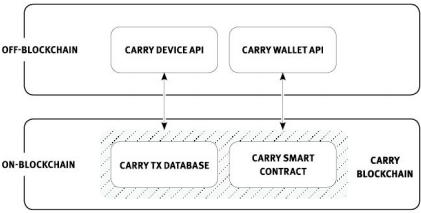
The Carry database is a virtual database which resides on the blockchain and enables transaction data to be uploaded and generated by consumers. The smart contracts enable the issuance and usage of tokens on the Carry Protocol.
However, the Carry wallet API allows wallets apps to aid Carry Protocol. Also, it enables consumers to easily manage their digital assets and have ownership of their transaction data and privacy settings. The Carry device API enables devices at conventional retail stores to easily integrate with the Carry Protocol thereby allowing consumers to have the flexibility of paying with cryptocurrency. It will also allow connected devices to send transaction data from the merchant's POS to the consumer's wallet.
Below simply illustrates the Carry Protocol business model:
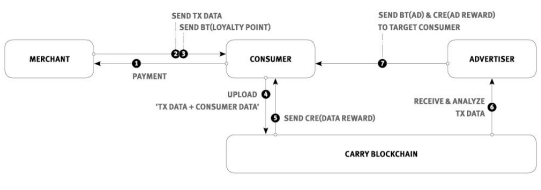
A customer goes to conventional retail stores to purchase items and make payments with his preferred payment method.
Based on his discretion, he can either share his transaction information anonymously with Carry Protocol for it to be uploaded on the blockchain or decide to keep it to himself.
He receives rewards in digital tokens or coupons for sharing his transaction information.
The key distinctive benefit of Carry Protocol
• Consumers can make payments using credit cards, fiat, or digital tokens.
• Payment processing and settlement occurs swiftly for merchants
• User-friendly and seamless protocol
• Consumers are rewarded in BT tokens for buying goods from merchants

• Consumers are rewarded in CRE tokens for sharing their anonymous transaction data and accepting advertisements.
• Merchants gain more visibility.
• Enables advertisers to monitor the efficacy of their ads.
• Provides branded tokens for merchants to enable them to issue it to consumers as a way of saying 'Thank You'
• The branded tokens also serve as a form of advertisement
• Settlement service providers earn rewards from settlement fees
• Wallet service and device providers also stand to benefit from the Carry Protocol.
• Value-added services
Carry Protocol also caters for settlement service providers, advertising service providers, wallet service providers, device providers, each with their respective functions on the Carry Protocol.
The wallet services providers help to produce and administer wallets to consumers in the form of mobile apps. The wallet will enable consumers to upload transaction data, manage transaction data, and store digital currencies. The wallet will also serve as an advertisement channel.
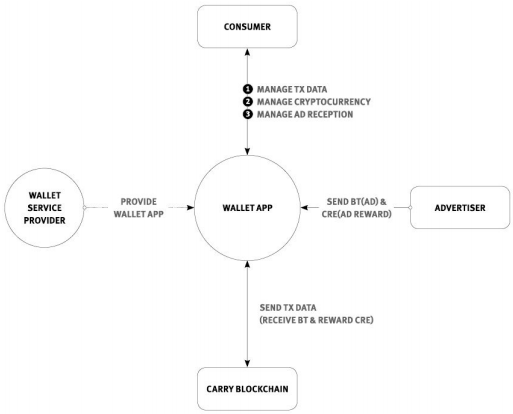
On the other hand, device providers are saddled with the responsibility of installing and configuring devices at conventional stores to enable merchants easily make use of the Carry Protocols in their respective stores.

The settlement service providers help with transaction settlements and also assist merchants who intend to convert their earned digital currencies into fiat money. However, the advertising service providers will help advertisers to examine and study transaction data so as to identify the prospective customer base and also carry out ad campaigns.
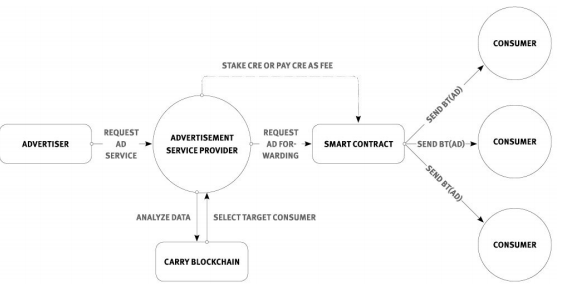
The Carry Protocol will make use of two tokens to fuel the ecosystem. They are Branded tokens (BT) and Carry Protocol token(CRE). The Branded tokens are tokens generated and issued through smart contracts by merchants or advertisers. It has a different use case and enables merchants and advertisers to issue it to consumers for specific purposes. The CRE token is the principal token of Carry Protocol and it can be used for activities such as stakes to implement smart contracts, reward in exchange for advertisement, and also means of payment.
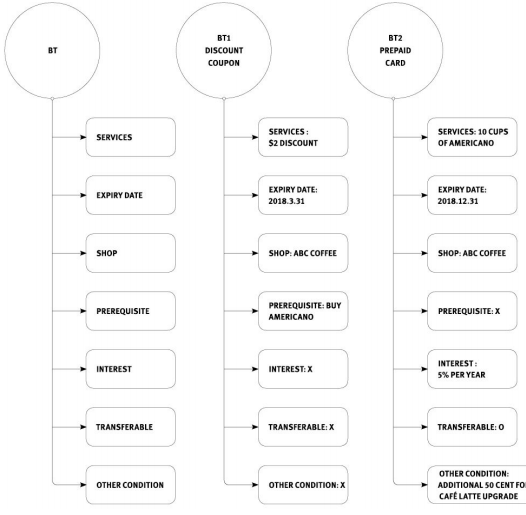
However, before merchants or advertisers can make use of the Carry smart contracts, they have the option to either stake some certain amount of CRE tokens on the Carry Protocol or Pay on the spot in CRE for each smart contract usage. However, once the daily usage has been reached and the entity still intends to use the smart contract, then an additional fee must be paid.
Carry Protocol has secured its first partnership with Spoqa, a big and outstanding organization that works closely with merchants in the offline market to design a tailored service that matches their needs. It has also secured partnership with other giants in the sector.

TOKEN
The Carry Protocol token (CRE) which is the main token, will be issued in the form of an ERC-20. It will be used to fuel the Carry Protocol.
Total Supply: 10,000,000,000 CRE
Token symbol: CRE
Hard cap: 15,000,000 USD
Current price: 1 CRE = 0.0093 USD
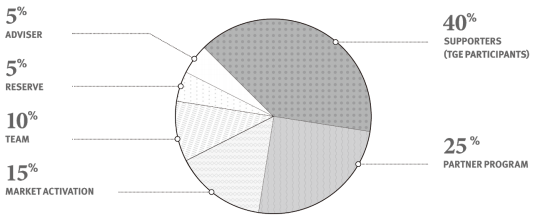
MAIN TEAM


Kindly visit https://www.carryprotocol.io/ for more information.
Whitepaper: https://www.carryprotocol.io/static/docs/Carry_protocol-white_paper%28ENG%29.pdf?cachebust=56ce7d511bc65d0aee3d8ba2b2d5c876
Twitter: https://twitter.com/carryprotocol
Telegram: https://t.me/carryprotocol
Writer: Sucre123456
BTT profile link: https://bitcointalk.org/index.php?action=profile;u=1820055;sa=summary